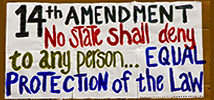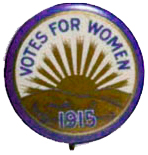
Gender, Law & Politics 46.320


Susan E. Gallagher, Associate Professor, Political Science


Required Readings
Marilynn Salmon, "The Legal Status of Women, 1776-1830," History Now, March 2006.
Susan E. Gallagher, "Gender," Encyclopedia of Privacy, edited by William G. Staples with advisory editors David J. Brown, Susan E. Gallagher, and Jill Joline Myers (Westport, CT: Greenwood Press, 2007).
Bradwell v. Illinois (1872), upheld exclusion of women from legal practice.
Louis Brandeis and Samuel Warren, "The Right to Privacy," Harvard Law Review (1890). Read introductory essay and main text.
Muller v. Oregon (1908), permitted sex discrimination in employment.

Background: Ian Milhiser, "The Troubled History Of The Constitution’s Most Important Amendment," Think Progress, July 9, 2015.

2. 1st Wave Feminism: Gaining Admission to the Public Sphere
Required Readings
Deborah M.S. Brown, "The Long Struggle for Women's Suffrage," U.S. Dept. of State, Learn North Carolina.
The Declaration of Sentiments of the Seneca Falls Convention (1848), Fordham University.
Susan E. Gallagher, Women's Suffrage and the Making of the White American Home
Monee Fields White, "Women's Suffrage and Racism: Ida B. Wells vs. Frances Willard," The Root, March 25, 2011.


3. 2nd Wave Feminism: A Struggle for Personal Liberation
Required Readings
Excerpt from Betty Friedan, The Feminine Mystique (1963).
Equal Pay Act of 1963, Equal Opportunity Commission.
National Organization for Women (NOW), Statement of Purpose (1966).
Stonewall Rebellion: Jerry Lisker, "Homo Nest Raided, Queen Bees Are Stinging Mad," New York Daily News, July 6, 1969.
Gloria Steinem, "Women's Liberation Aims to Free Men Too," Washington Post, June 7, 1970.
Barbara Winslow, "The Impact of Title IX," History Now 23 (Spring 2010), Gilder Lehrman Institute.
Meritor Savings v. Vinson (1986), defined liability in cases of sexual harassment, summary by Alison Shay, Publishing the Long Civil Rights Movement.




4. The Public/Private Dichotomy in the 20th Century
Required Readings
Griswold v. Connecticut (1965), summary and contextual notes, PBS.
A History of Key Abortion Rulings of the U.S. Supreme Court, Pew Research Center.
Bowers v. Hardwick (1986), held that the right to privacy does not extend to same-sex sexual relationships.
Defense of Marriage Act (DOMA) (1996), banned federal recognition of same-sex marriages.
Romer v. Evans (1996), prohibited states from enacting laws designed to discriminate against gay and lesbian people, "The Gay Rights Ruling," summary and excerpts, New York Times, May 21, 1996.


5. Gender, Race & Justice
Required Readings
Ida B. Wells, "Lynch Law," 1893.
Loving v. Virginia (1967), overturned state laws against interracial marriage.
Michelle Alexander, “The New Jim Crow: How Mass Incarceration Turns People of Color into Permanent Second-Class Citizens,” American Prospect, December 6, 2010.
Michelle Alexander, "Telling My Son about Ferguson," Op-Ed, New York Times, November 26, 2014.
"Lynching as Racial Terrorism," Editorial, New York Times, February 11, 2015.



6. Gender and the Expansion of Civil Rights in the 21st Century
Required Readings
Lawrence v. Texas (2003), overturned Bowers v. Hardwick (1986) by including same-gender sexual activity within a general right to privacy.
Goodridge v. Department of Public Health (2003), held that prohibiting same-gender marriage violates constitutional protection of equal treatment under law: "The Goodridge Decision and the Right to Marry," Massachusetts Law Review.
California Proposition 8, the "Eliminates Right of Same-Sex Couples to Marry" Initiative (2008), ballotpedia.org.
"Why 6 federal judges struck down state gay marriage bans, in their own words," Washington Post, February 27, 2014.
Obergefell v. Hodges (2015), overturned state laws against same-gender marriage: Adam Liptak, "Supreme Court Ruling Makes Same-Sex Marriage a Right," New York Times, June 26, 2015.


7. Gender & Economic Inequality in the U.S.: Current Trends
Required Readings
Catherine Hill, "The Simple Truth about the Gender Pay Gap," American Association of University Women, (Fall 2015).
Alison Perlberg, "Shortchanged: Women and the Wealth Gap," Clayman Institute for Gender Research, April 4, 2011.
Matt Brunig, "The Racial Wealth Gap," American Prospect, November 6, 2013.


